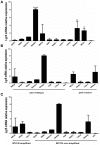Stem Cell Markers in Neuroblastoma-An Emerging Role for LGR5
- PMID: 26697427
- PMCID: PMC4667032
- DOI: 10.3389/fcell.2015.00077
Stem Cell Markers in Neuroblastoma-An Emerging Role for LGR5
Abstract
The prognostic value of cancer stem cell markers in various cancer subtypes is a well documented research area. Our findings show that the stem cell marker Lgr5 is associated with an aggressive phenotype in neuroblastoma. Here, we discuss these findings within the context of recent studies in several cancers such as lung, colorectal and intestinal cancer, glioblastoma and ewing's sarcoma. Neuroblastoma continues to be an elusive disease, due to its heterogeneous presentation ranging from spontaneous regression to aggressive metastatic disease and intertwined genetic variability. Currently, the most significant prognostic marker of high risk disease and poor prognosis is amplification of the MYCN oncogene, which is found in approximately 25% of cases (Huang and Weiss, 2013). With this in mind, there is still much to learn about the driving mechanisms of this aggressive pediatric tumor. Neuroblastoma development is thought to be the result of aberrant differentiation of the cell of origin, embryonic neural crest cells which then migrate and invade during the developmental stage (Joshi et al., 2007). Aberrant cells are those which would, under normal conditions form the mature tissues of the sympathetic ganglia and adrenal medulla. Tumors are known to develop indiscriminately along the radius of the sympathetic ganglia, although it is well established that the adrenal glands are fundamentally the most common primary site (Jessen and Mirsky, 2005).
Keywords: LGR5; chemoresistance; neuroblastoma; relapse.
Figures


Similar articles
-
The MYCN oncogene and differentiation in neuroblastoma.Semin Cancer Biol. 2011 Oct;21(4):256-66. doi: 10.1016/j.semcancer.2011.08.001. Epub 2011 Aug 9. Semin Cancer Biol. 2011. PMID: 21849159 Review.
-
A developmental model of neuroblastoma: differentiating stroma-poor tumors' progress along an extra-adrenal chromaffin lineage.Lab Invest. 1996 Nov;75(5):659-75. Lab Invest. 1996. PMID: 8941212
-
Neuroblastoma pathogenesis: deregulation of embryonic neural crest development.Cell Tissue Res. 2018 May;372(2):245-262. doi: 10.1007/s00441-017-2747-0. Epub 2017 Dec 8. Cell Tissue Res. 2018. PMID: 29222693 Free PMC article. Review.
-
Biological and Genetic Features of Neuroblastoma and Their Clinical Importance.Curr Pediatr Rev. 2018;14(2):73-90. doi: 10.2174/1573396314666180129101627. Curr Pediatr Rev. 2018. PMID: 29380702 Review.
-
Alternative NHEJ pathway proteins as components of MYCN oncogenic activity in human neural crest stem cell differentiation: implications for neuroblastoma initiation.Cell Death Dis. 2017 Dec 13;8(12):3208. doi: 10.1038/s41419-017-0004-9. Cell Death Dis. 2017. PMID: 29238067 Free PMC article.
Cited by
-
Patient-derived organoids (PDOs) as a novel in vitro model for neuroblastoma tumours.BMC Cancer. 2019 Oct 21;19(1):970. doi: 10.1186/s12885-019-6149-4. BMC Cancer. 2019. PMID: 31638925 Free PMC article.
-
Cancer Stem Cells in Neuroblastoma: Expanding the Therapeutic Frontier.Front Mol Neurosci. 2019 May 27;12:131. doi: 10.3389/fnmol.2019.00131. eCollection 2019. Front Mol Neurosci. 2019. PMID: 31191243 Free PMC article. Review.
-
Cancer stem cells in neuroblastoma therapy resistance.Cancer Drug Resist. 2019 Dec 19;2(4):948-967. doi: 10.20517/cdr.2019.72. Epub 2019 Nov 11. Cancer Drug Resist. 2019. PMID: 31867574 Free PMC article.
-
Therapy resistance in neuroblastoma: Mechanisms and reversal strategies.Front Pharmacol. 2023 Feb 16;14:1114295. doi: 10.3389/fphar.2023.1114295. eCollection 2023. Front Pharmacol. 2023. PMID: 36874032 Free PMC article. Review.
-
Identification of novel prognostic markers of survival time in high-risk neuroblastoma using gene expression profiles.Oncotarget. 2020 Nov 17;11(46):4293-4305. doi: 10.18632/oncotarget.27808. eCollection 2020 Nov 17. Oncotarget. 2020. PMID: 33245713 Free PMC article.
References
-
- Balamuth N. J., Wood A., Wang Q., Jagannathan J., Mayes P., Zhang Z., et al. . (2010). Serial transcriptome analysis and cross-species integration identifies centromere-associated protein E as a novel neuroblastoma target. Cancer Res. 70, 2749–2758. 10.1158/0008-5472.can-09-3844 - DOI - PMC - PubMed
LinkOut - more resources
Full Text Sources
Other Literature Sources

